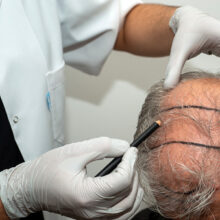Let’s Get Personal: How to Discover Your Specific Skin Type
- Published: Monday, April 6th 2015
- in Beauty
The philosophy behind Japanese skin care focuses on balance. Instead of working against your skin type, it’s important to determine what your skin needs and using nourishing ingredients to keep it in harmony. Applying a formula that is too rich for oily skin, for example, can congest your skin. Discovering your skin type is an effective first step to finding your best daily ritual.
One trick I learned to find my skin type was to use a sheet of blotting paper and to blot the different areas of my face: my forehead, nose, cheeks, and chin. Study the blotting sheet after patting each area to see where your skin is dry or oily. If you don’t have a blotting sheet handy, think of where you tend to have shininess or alternatively, where you feel tightness or dryness.
If your blotting sheet picked up very little or no oil, you most likely have dry skin. The good thing about dry skin is that it is less prone to breaking out. Dry skin can feel tight and sometimes flake. The main cause of dry skin is usually genetic, but diet, lifestyle, hormonal changes and environment can be contributing factors as well. Dehydration can lead to dry skin, so be sure to stay hydrated by drinking plenty of water, and avoiding diuretics like alcohol and caffeine. To brighten dry skin, look for nonabrasive, gentle exfoliators. Fruit and rice enzymes, which work well for all skintypes, will help promote skin cell turnover without excessively drying your skin. Exfoliation will also slough away dead skin cells and prepare your skin to effectively absorb any other treatments you use. For moisture, look for items containing hyaluronic acid (listed often as sodium hyaluronate on the ingredient deck), glycerin, and marine actives like algae, all of which attract water and deliver it directly to skin cells. Emollient ingredients such as squalane and camellia oil help to smooth out your skin and hydrate it evenly for a luminous glow.
If your blotting sheet shows oiliness on your nose and forehead (also called the t-zone), you most likely have normal/combination skin. Individuals with this skin type typically do not have breakouts on their cheeks, and have the benefit of a naturally moisturized t-zone. People with normal/combination skin tend to have dryness on the cheeks, so it’s important to find a formula that will not weigh down your skin, but still help it retain moisture. A gentle yet effective exfoliant will decongest your t-zone and keep your cheeks refreshed. Fruit and rice enzymes, again, are suitable to exfoliate combination skin because they clear and tighten pores and give skin a polished glow. Look for moisturizers with a gel-like texture, as they tend to be absorbed more quickly. Emollients in some formulas may be too rich, so be mindful of their texture and effects on your skin when you use them.
If your blotting sheet lifted oiliness on your cheeks as well as your forehead and nose, you most likely have oily skin. The wonderful news is that oily skin is young skin, meaning your skin is doesn’t wrinkle as quickly and naturally holds in moisture. Individuals with oily skin usually find that their pores congest easily. To help deeply cleanse oily skin, as with all skin types, I recommend daily enzymatic exfoliation with fruit and rice. Regular, gentle exfoliation promotes cell turnover and prevents pores from clogging. A gentle physical exfoliator (that does not use abrasives such as crushed nuts or seeds) can also help smooth skin’s texture. Oily skin is also prone to PIH (post-inflammatory hyperpigmentation), which are the dark spots that can remain after a breakout. Over time, regular exfoliation helps to lighten up these dark spots as the uppermost layers of skin are polished away. If you experience acneic breakouts, using an exfoliator that includes anti-bacterial ingredients will help speed up healing and prevent future blemishes.
A special note on sensitive skin: Sensitive skin can be tricky to treat. The good news is, your sensitive skin’s quick reactions help you recognize early on when a product is too harsh, rather than manifesting over a long time. To help narrow down the ingredients or formulas you may react to, try only one new item each time, for both makeup and skincare. I always recommend a patch test for sensitive skin to minimize any potential reactions on the face. First, try a new formula on your inner forearm. If your skin takes to it well, try the formula on the area right behind your ear before using it on your face. Seek formulas that are non-sensitizing and non-irritating.
I recommend that everyone stay away from parabens, synthetic fragrances, mineral oil, sulfate detergents, phthalates, urea, DEA or TEA, as these ingredients can be harmful for your health.
Like a field of wildflowers, our skin types can vary and may even change over time. Skin is an intelligent organ that reflects our health and environment. The delightful news is that all skintypes can benefit from gentle, enzymatic exfoliation that cleanses and prepares it for any treatments used afterwards.
Like these tips from Victoria? Then you’ll love TATCHA. Enter for a chance to win TATCHA’s at-home Japanese spa experience giveaway here!




